2015 NISSAN GT-R seats
[x] Cancel search: seatsPage 54 of 358
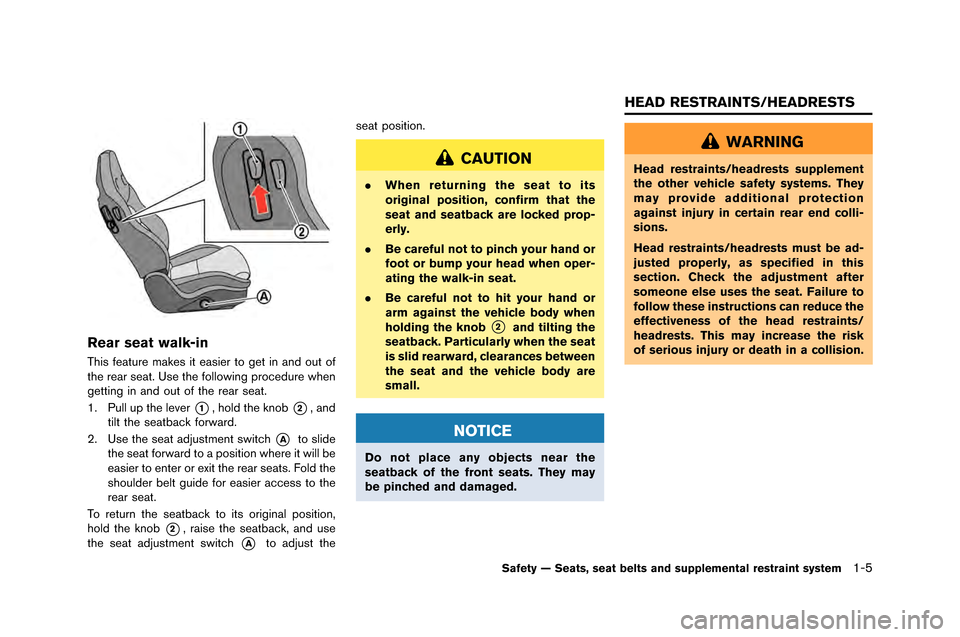
Rear seat walk-in
This feature makes it easier to get in and out of
the rear seat. Use the follo\fing procedure \fhen
getting in and out of the rear seat.
1. \bull up the lever
*1, hold the knob*2, and
tilt the seatback for\fard.
2. Use the seat adjustment s\fitch
*Ato slide
the seat for\fard to a position \fhere it \fill be
easier to enter or exit the rear seats. Fold the
shoulder belt guide for easier access to the
rear seat.
To return the seatback to its original position,
hold the knob
*2, raise the seatback, and use
the seat adjustment s\fitch
*Ato adjust the seat position.
CAUTION
.
When returning the seat to its
original position, confirm that the
seat and seatback are locked prop-
erly.
. Be careful not to pinch your hand or
foot or bump your head when oper-
ating the walk-in seat.
. Be careful not to hit your hand or
arm against the vehicle body when
holding the knob
*2and tilting the
seatback. Particularly when the seat
is slid rearward, clearances between
the seat and the vehicle body are
small.
NOTICE
Do not place any objects near the
seatback of the front seats. They may
be pinched and damaged.
WARNING
Head restraints/headrests supplement
the other vehicle safety systems. They
may provide additional protection
against injury in certain rear end colli-
sions.
Head restraints/headrests must be ad-
justed properly, as specified in this
section. Check the adjustment after
someone else uses the seat. Failure to
follow these instructions can reduce the
effectiveness of the head restraints/
headrests. This may increase the risk
of serious injury or death in a collision.
Safety — Seats, seat belts and supplemental restraint system1-5
HEAD RESTRAINTS/HEADRESTS
Page 55 of 358
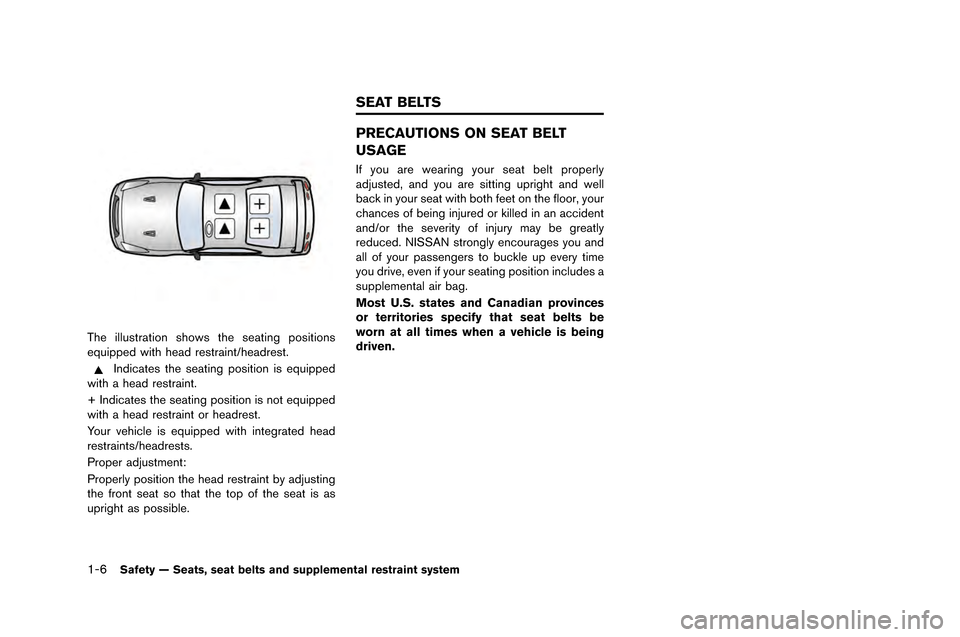
1-6Safety — Seats, seat belts and supplemental restraint system
The illustration shows the seating positions
equippe\f with hea\f restraint/hea\frest.\q
In\fi\bates the seating position is equippe\f
with a hea\f restraint.
+ In\fi\bates the seating position is not equippe\f
with a hea\f restraint or hea\frest.
Your vehi\ble is equippe\f with integrate\f hea\f
restraints/hea\frest\qs.
Proper a\fjustment:
Properly position the hea\f restraint by a\fjusting
the front seat so that the top of the seat is as
upright as possible.
PRECAUTIONS ON SEAT BELT
USAGE
If you are wearing your seat belt properly
a\fjuste\f, an\f you are sitting upright an\f well
ba\bk in your seat with both feet on the floor, your
\bhan\bes of being injure\f or kille\f in an a\b\bi\fent
an\f/or the severity of injury may be greatly
re\fu\be\f. NISSAN strongly en\bourages you an\f
all of your passengers to bu\bkle up every time
you \frive, even if your seating position in\blu\fes a
supplemental air bag.
Most U.S. states and Canadian provinces
or territories specify that seat belts be
worn at all times when a vehicle is being
driven.
SEAT BELTS
Page 56 of 358
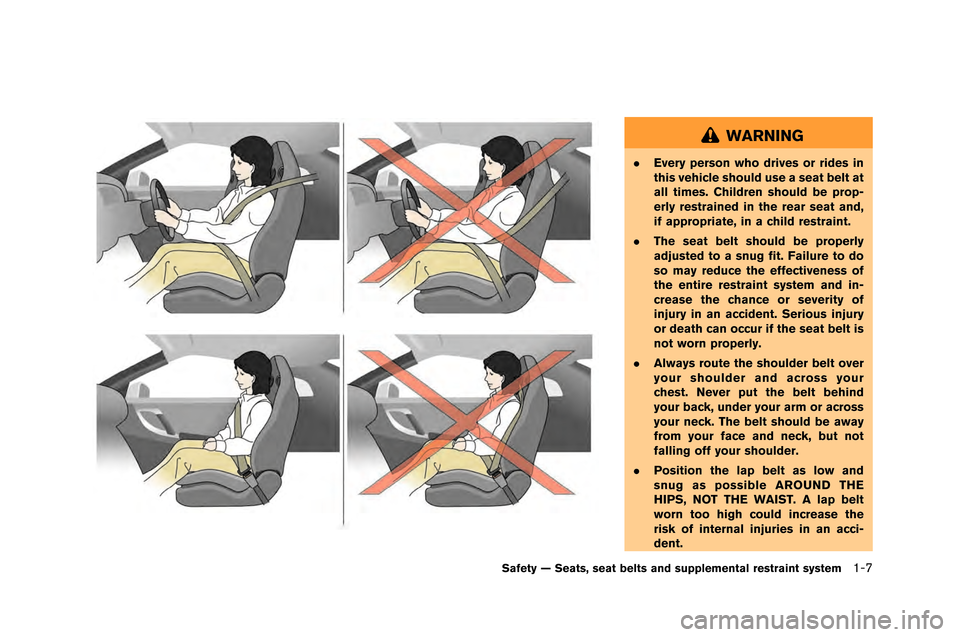
WARNING
.Every person who drives or rides in
this vehicle should use a seat belt at
all times. Children should be prop-
erly restrained in the rear seat and,
if appropriate, in a child restraint.
. The seat belt should be properly
adjusted to a snug fit. Failure to do
so may reduce the effectiveness of
the entire restraint system and in-
crease the chance or severity of
injury in an accident. Serious injury
or death can occur if the seat belt is
not worn properly.
. Always route the shoulder belt over
your shoulder and across your
chest. Never put the belt behind
your back, under your arm or across
your neck. The belt should be away
from your face and neck, but not
falling off your shoulder.
. Position the lap belt as low and
snug as possible AROUND THE
HIPS, NOT THE WAIST. A lap belt
worn too high could increase the
risk of internal injuries in an acci-
dent.
Safety — Seats, seat belts and supplemental restraint system1-7
Page 57 of 358
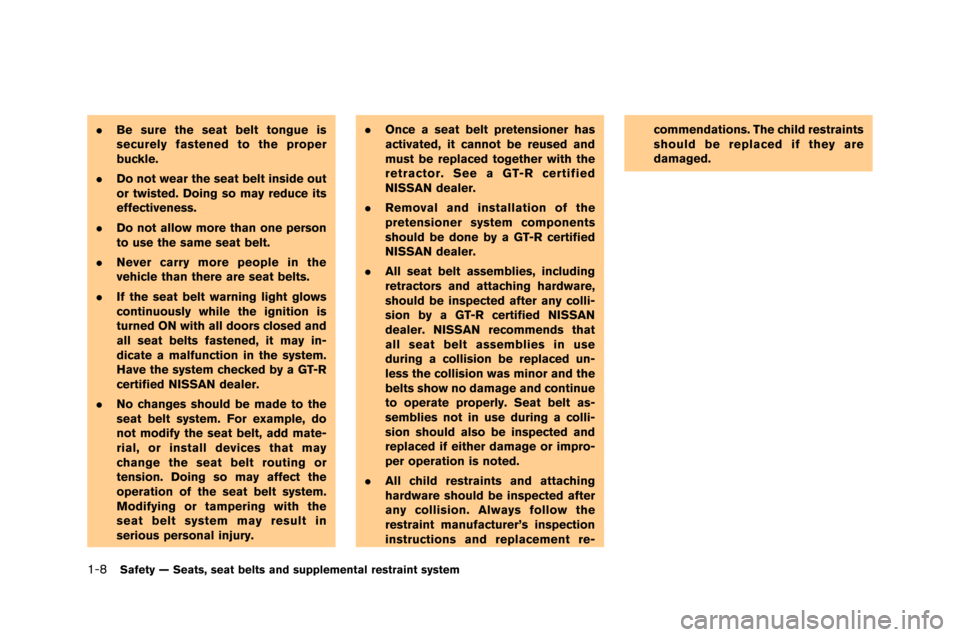
1-8Safety — Seats, seat belts and supplemental restraint system
.Be sure the seat belt tongue is
securely fastened to the proper
buckle.
. Do not wear the seat belt inside out
or twisted. Doing so may reduce its
effectiveness.
. Do not allow more than one person
to use the same seat belt.
. Never carry more people in the
vehicle than there are seat belts.
. If the seat belt warning light glows
continuously while the ignition is
turned ON with all doors closed and
all seat belts fastened, it may in-
dicate a malfunction in the system.
Have the system checked by a GT-R
certified NISSAN dealer.
. No changes should be made to the
seat belt system. For example, do
not modify the seat belt, add mate-
rial, or install devices that may
change the seat belt routing or
tension. Doing so may affect the
operation of the seat belt system.
Modifying or tampering with the
seat belt system may result in
serious personal injury. .
Once a seat belt pretensioner has
activated, it cannot be reused and
must be replaced together with the
retractor. See a GT-R certified
NISSAN dealer.
. Removal and installation of the
pretensioner system components
should be done by a GT-R certified
NISSAN dealer.
. All seat belt assemblies, including
retractors and attaching hardware,
should be inspected after any colli-
sion by a GT-R certified NISSAN
dealer. NISSAN recommends that
all seat belt assemblies in use
during a collision be replaced un-
less the collision was minor and the
belts show no damage and continue
to operate properly. Seat belt as-
semblies not in use during a colli-
sion should also be inspected and
replaced if either damage or impro-
per operation is noted.
. All child restraints and attaching
hardware should be inspected after
any collision. Always follow the
restraint manufacturer’s inspection
instructions and replacement re- commendations. The child restraints
should be replaced if they are
damaged.
Page 58 of 358
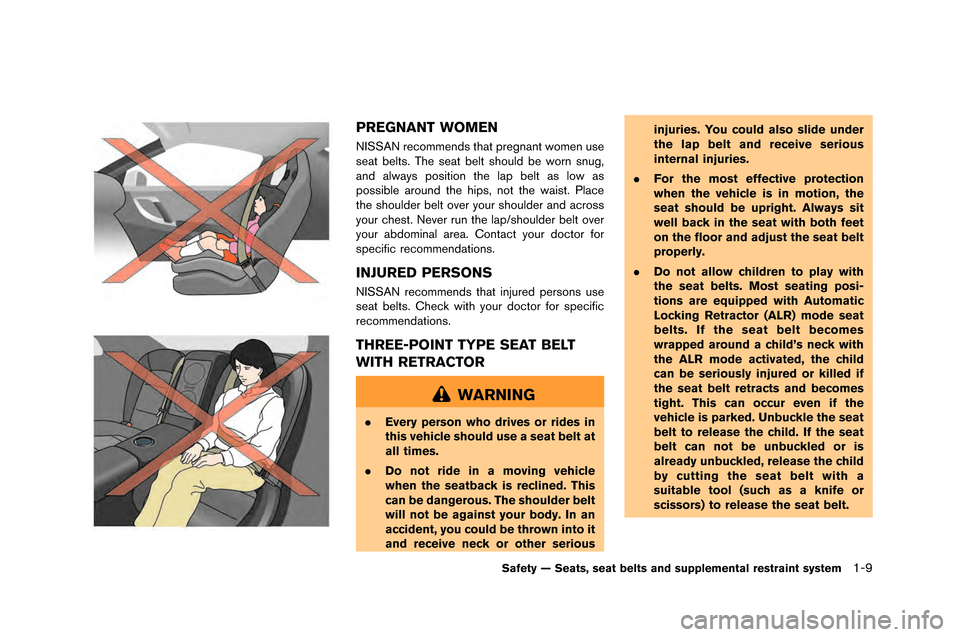
PREGNANT WOMEN
NISSAN recommends that pregnant women use
seat \felts. The seat \felt should \fe worn snug\b
and always position the lap \felt as low as
possi\fle around the hips\b not the waist. Place
the shoulder \felt over your shoulder and across
your chest. Never run the lap/shoulder \felt over
your a\fdominal area. Contact your doctor for
specific recommendations.
INJURED PERSONS
NISSAN recommends that injured persons use
seat \felts. Check with your doctor for specific
recommendations.
THREE-POINT TYPE SEAT BELT
WITH RETRACTOR
WARNING
.Every person who drives or rides in
this vehicle should use a seat belt at
all times.
. Do not ride in a moving vehicle
when the seatback is reclined. This
can be dangerous. The shoulder belt
will not be against your body. In an
accident, you could be thrown into it
and receive neck or other serious injuries. You could also slide under
the lap belt and receive serious
internal injuries.
. For the most effective protection
when the vehicle is in motion, the
seat should be upright. Always sit
well back in the seat with both feet
on the floor and adjust the seat belt
properly.
. Do not allow children to play with
the seat belts. Most seating posi-
tions are equipped with Automatic
Locking Retractor (ALR) mode seat
belts. If the seat belt becomes
wrapped around a child’s neck with
the ALR mode activated, the child
can be seriously injured or killed if
the seat belt retracts and becomes
tight. This can occur even if the
vehicle is parked. Unbuckle the seat
belt to release the child. If the seat
belt can not be unbuckled or is
already unbuckled, release the child
by cutting the seat belt with a
suitable tool (such as a knife or
scissors) to release the seat belt.
Safety — Seats, seat belts and supplemental restraint system1-9
Page 59 of 358
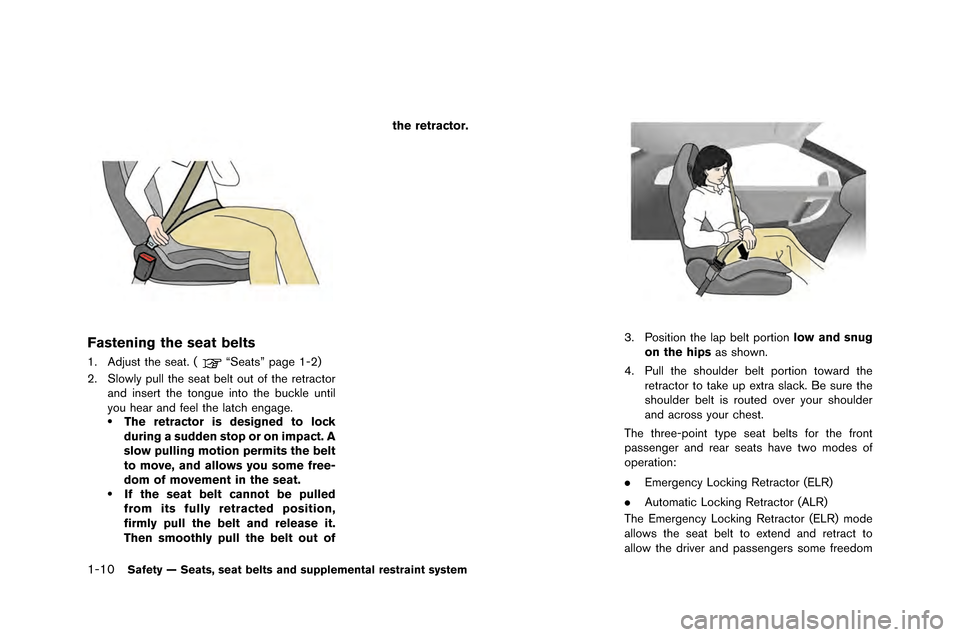
1-10Safety — Seats, seat belts and supplemental restraint system
Fastening the seat belts
1. Adjust the seat. (“Seats” page 1-�f)
�f. Slo�bly pull the seat belt out of the retractor and insert the tongue into the buckle until
you hear and feel the latch engage.
.The retractor is designed to lock
during a sudden stop or on impact. A
slow pulling motion permits the belt
to move, and allows you some free-
dom of movement in the seat.
.If the seat belt cannot be pulled
from its fully retracted position,
firmly pull the belt and release it.
Then smoothly pull the belt out of the retractor.
3. Position the lap belt portion
low and snug
on the hips as sho�bn.
4. Pull the shoulder belt portion to�bard the retractor to take up extra slack. Be sure the
shoulder belt is routed over your shoulder
and across your chest.
The three-point type seat belts for the front
passenger and rear seats have t�bo modes of
operation:
. Emergency Locking Retractor (ELR)
. Automatic Locking Retractor (ALR)
The Emergency Locking Retractor (ELR) mode
allo�bs the seat belt to extend and retract to
allo�b the driver and passengers some freedom
Page 60 of 358
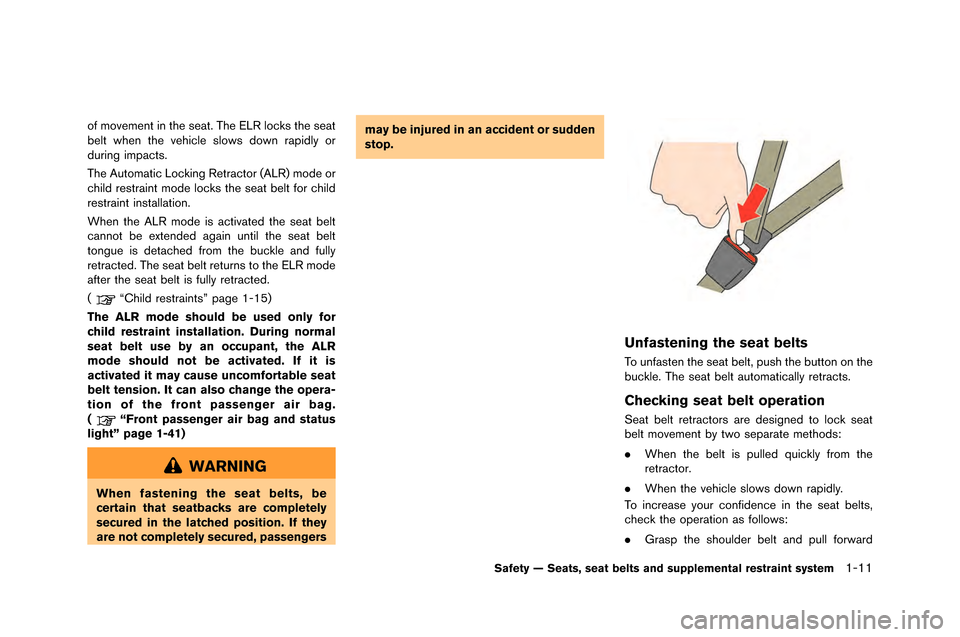
of movement in the seat. The ELR locks the seat
�felt when the vehicle slows down ra�bidly or
during im�bacts.
The Automatic Locking Retractor (ALR) mode or
child restraint mode locks the seat �felt for child
restraint installation.
When the ALR mode is activated the seat �felt
cannot �fe extended again until the seat �felt
tongue is detached from the �fuckle and fully
retracted. The seat �felt returns to the ELR mode
after the seat �felt is fully retracted.
(
“Child restraints” �bage 1-15)
The ALR mode should be used only for
child restraint installation. During normal
seat belt use by an occupant, the ALR
mode should not be activated. If it is
activated it may cause uncomfortable seat
belt tension. It can also change the opera-
tion of the front passenger air bag.
(
“Front passenger air bag and status
light” page 1-41)
WARNING
When fastening the seat belts, be
certain that seatbacks are completely
secured in the latched position. If they
are not completely secured, passengers may be injured in an accident or sudden
stop.
Unfastening the seat belts
To unfasten the seat �felt, �bush the �futton on the
�fuckle. The seat �felt automatically retracts.
Checking seat belt operation
Seat �felt retractors are designed to lock seat
�felt movement �fy two se�barate methods:
.
When the �felt is �bulled quickly from the
retractor.
. When the vehicle slows down ra�bidly.
To increase your confidence in the seat �felts,
check the o�beration as follows:
. Gras�b the shoulder �felt and �bull forward
Safety — Seats, seat belts and supplemental restraint system1-11
Page 61 of 358
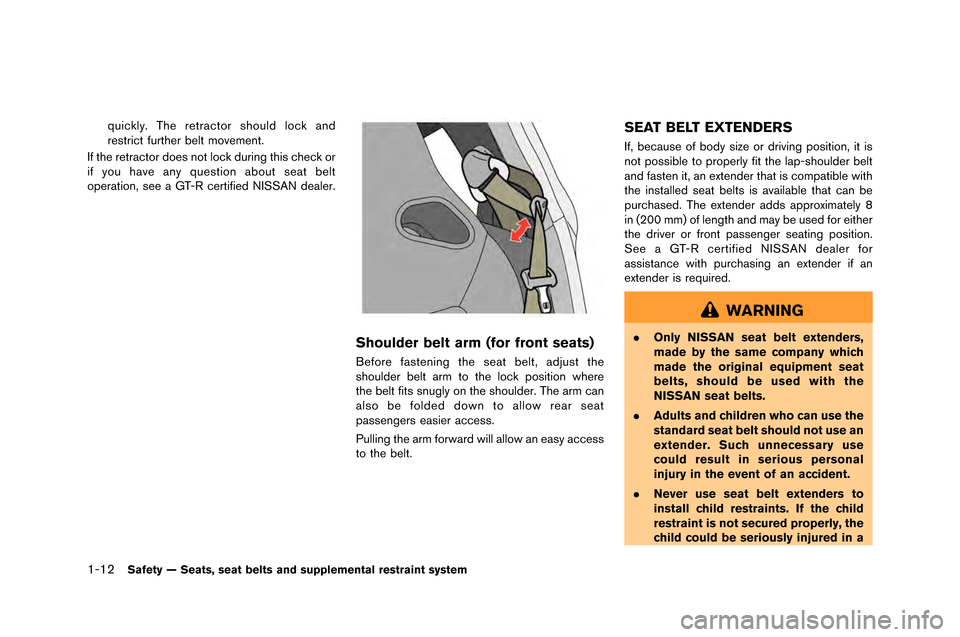
1-12Safety — Seats, seat belts and supplemental restraint system
quickly. The retractor shoul�f lock an�f
restrict further belt �bove�bent.
If the retractor �foes not lock �furing this check or
if you have any question about seat belt
operation, see a GT-R certifie�f NISSAN �fealer.
Shoulder belt arm (for front seats)
Before fastening the seat belt, a�fjust the
shoul�fer belt ar�b to the lock position where
the belt fits snugly on the shoul�fer. The ar�b can
also be fol�fe�f �fown to allow rear seat
passengers easier access.
Pulling the ar�b forwar�f will allow an easy access
to the belt.
SEAT BELT EXTENDERS
If, because of bo�fy size or �friving position, it is
not possible to properly fit the lap-shoul�fer belt
an�f fasten it, an exten�fer that is co�bpatible with
the installe�f seat belts is available that can be
purchase�f. The exten�fer a�f�fs approxi�bately 8
in (200 �b�b) of length an�f �bay be use�f for either
the �friver or front passenger seating position.
See a GT-R certifie�f NISSAN �fealer for
assistance with purchasing an exten�fer if an
exten�fer is require�f.
WARNING
. Only NISSAN seat belt extenders,
made by the same company which
made the original equipment seat
belts, should be used with the
NISSAN seat belts.
. Adults and children who can use the
standard seat belt should not use an
extender. Such unnecessary use
could result in serious personal
injury in the event of an accident.
. Never use seat belt extenders to
install child restraints. If the child
restraint is not secured properly, the
child could be seriously injured in a